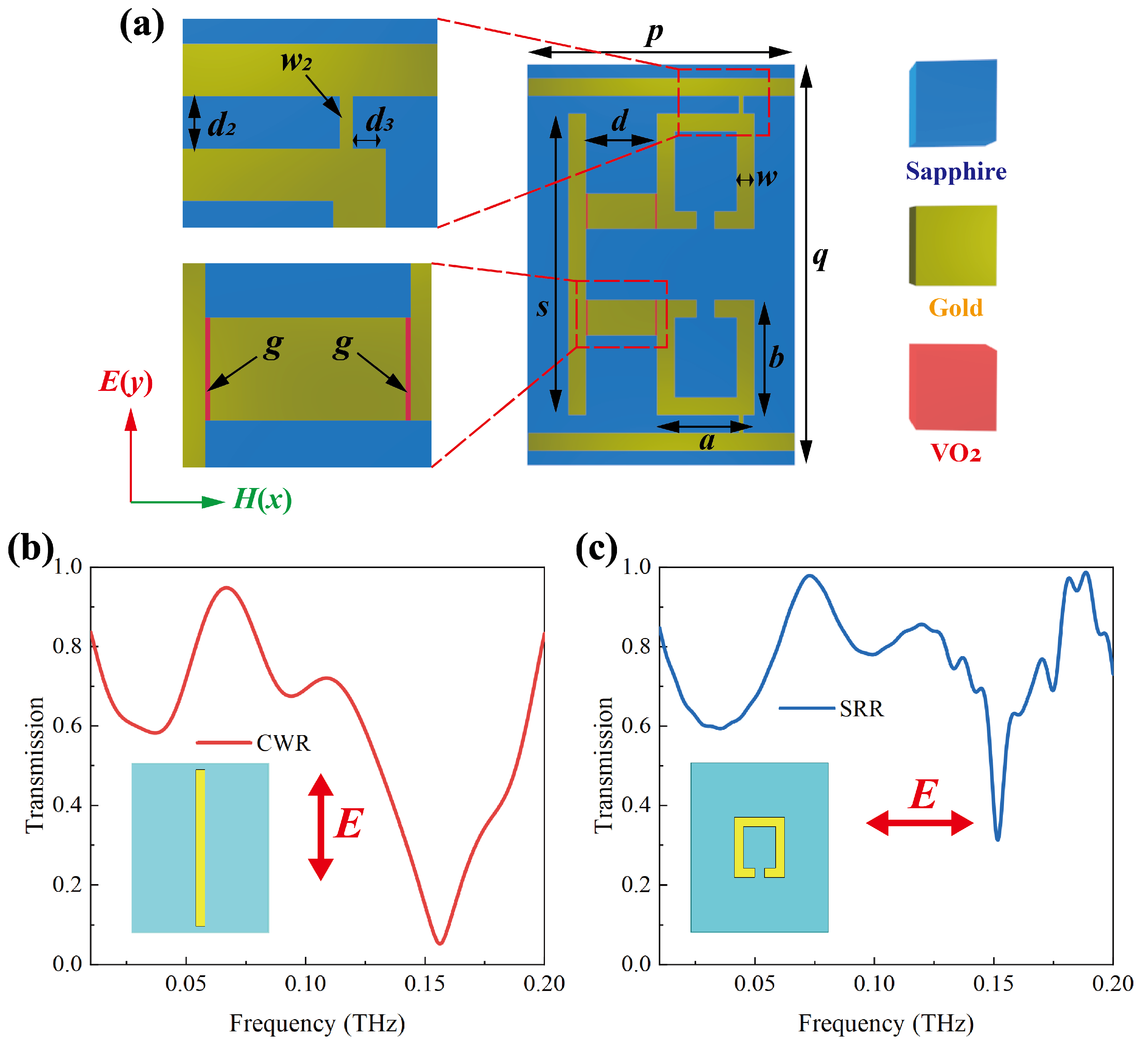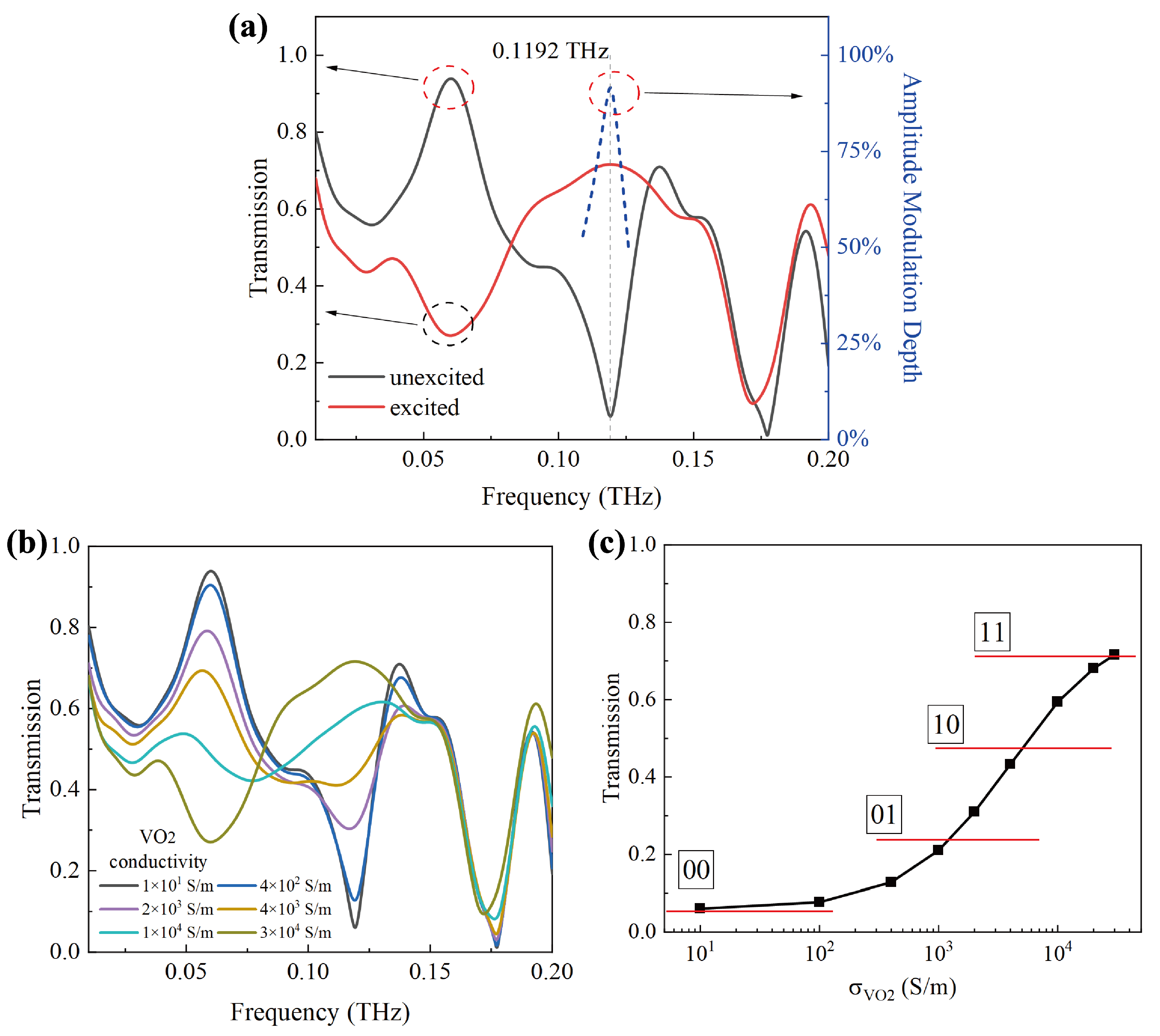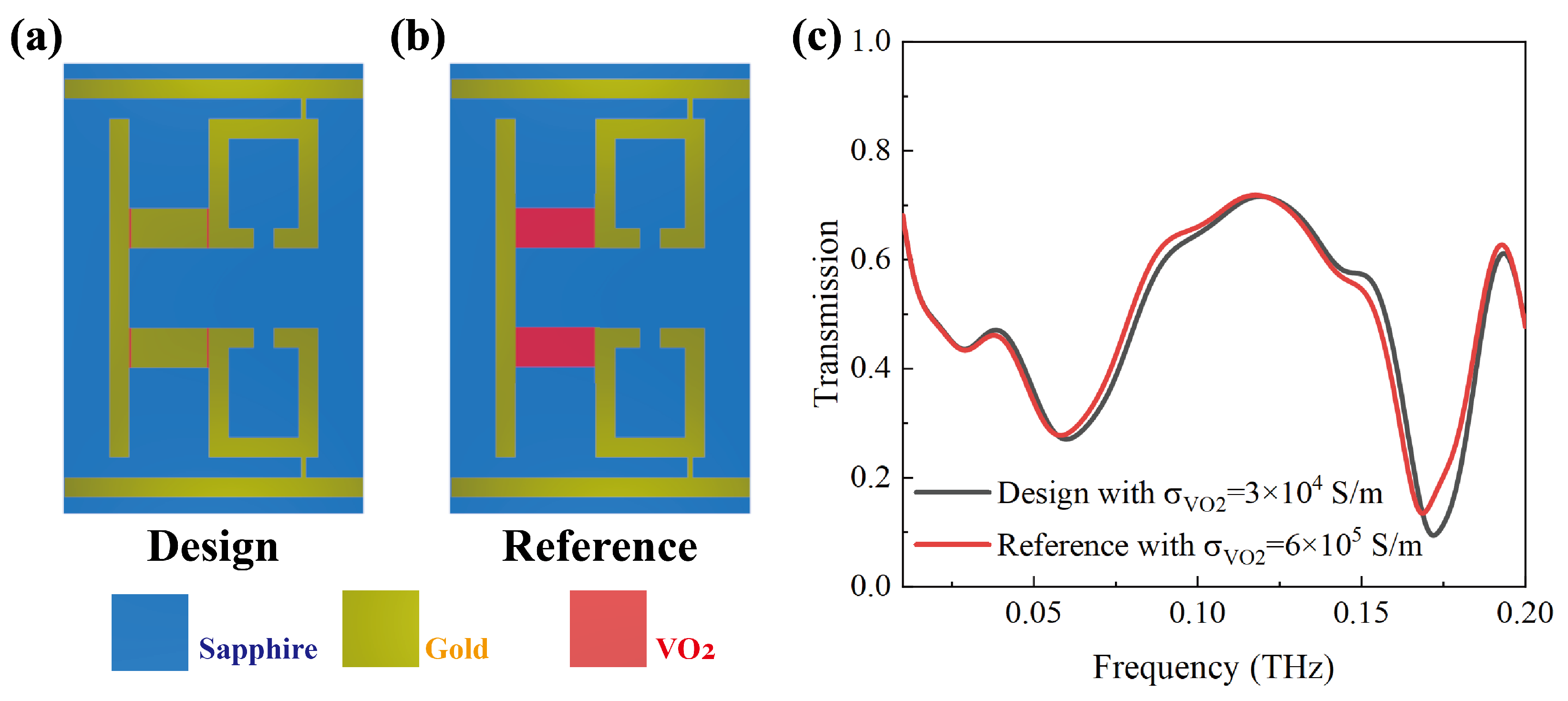Reconfigurable EIT Metasurface with Low Excited Conductivity of VO2
Abstract
1. Introduction
2. Theory and Design
3. Results and Discussion
4. Conclusions
Author Contributions
Funding
Institutional Review Board Statement
Informed Consent Statement
Data Availability Statement
Conflicts of Interest
Abbreviations
| THz | terahertz |
| EM | electromagnetic |
| EIT | electromagnetically induced transparency |
| vanadium dioxide | |
| CWR | cut wire resonator |
| SRR | split-ring resonator |
| AMD | amplitude modulation depth |
References
- Huang, Y.; Shen, Y.; Wang, J. From Terahertz Imaging to Terahertz Wireless Communications. Engineering 2023, 22, 106–124. [Google Scholar] [CrossRef]
- Sarieddeen, H.; Saeed, N.; Al-Naffouri, T.; Alouini, M.S. Next Generation Terahertz Communications: A Rendezvous of Sensing, Imaging, and Localization. IEEE Commun. Mag. 2020, 58, 69–75. [Google Scholar] [CrossRef]
- Degl’Innocenti, R.; Lin, H.; Navarro-Cía, M. Recent progress in terahertz metamaterial modulators. Nanophotonics 2022, 11, 1485–1514. [Google Scholar] [CrossRef]
- Wang, L.; Zhang, Y.; Guo, X.; Chen, T.; Liang, H.; Hao, X.; Hou, X.; Kou, W.; Zhao, Y.; Zhou, T.; et al. A Review of THz Modulators with Dynamic Tunable Metasurfaces. Engineering 2019, 9, 965. [Google Scholar] [CrossRef] [PubMed]
- Saifullah, Y.; He, Y.; Boag, A.; Yang, G.; Xu, F. Recent Progress in Reconfigurable and Intelligent Metasurfaces: A Comprehensive Review of Tuning Mechanisms, Hardware Designs, and Applications. Adv. Sci. 2022, 9, 2203747. [Google Scholar] [CrossRef]
- Zhang, L.; Cui, T. Space-Time-Coding Digital Metasurfaces: Principles and Applications. Research 2021, 2021, 9802673. [Google Scholar] [CrossRef]
- Tian, H.; Shen, H.; Zhang, X.; Li, X.; Jiang, W.; Cui, T. Terahertz Metasurfaces: Toward Multifunctional and Programmable Wave Manipulation. Front. Phys. 2020, 8, 584077. [Google Scholar] [CrossRef]
- Cui, T.; Bai, B.; Sun, H. Tunable Metasurfaces Based on Active Materials. Adv. Funct. Mater. 2019, 29, 1806692. [Google Scholar] [CrossRef]
- Zhang, Y.; Qiao, S.; Liang, S.; Wu, Z.; Yang, Z.; Feng, Z.; Sun, H.; Zhou, Y.; Sun, L.; Chen, Z.; et al. Gbps Terahertz External Modulator Based on a Composite Metamaterial with a Double-Channel Heterostructure. Nano Lett. 2015, 15, 3501–3506. [Google Scholar] [CrossRef]
- Zhang, Y.; Qiao, S.; Sun, L.; Shi, Q.; Huang, W.; Li, L.; Yang, Z. Photoinduced active terahertz metamaterials with nanostructured vanadium dioxide film deposited by sol-gel method. Opt. Express 2014, 22, 11070. [Google Scholar] [CrossRef]
- Lan, F.; Wang, L.; Zeng, H.; Liang, S.; Song, T.; Liu, W.; Mazumder, P.; Yang, Z.; Zhang, Y.; Mittleman, D. Real-time programmable metasurface for terahertz multifunctional wave front engineering. Light Sci. Appl. 2023, 12, 191. [Google Scholar] [CrossRef] [PubMed]
- Liu, M.; Plum, E.; Li, H.; Duan, S.; Li, S.; Xu, Q.; Zhang, X.; Zhang, C.; Zou, C.; Jin, B.; et al. Switchable Chiral Mirrors. Adv. Opt. Mater. 2020, 8, 2000247. [Google Scholar] [CrossRef]
- Liu, M.; Xu, Q.; Chen, X.; Plum, E.; Li, H.; Zhang, X.; Zhang, C.; Zou, C.; Han, J.; Zhang, W. Temperature-Controlled Asymmetric Transmission of Electromagnetic Waves. Sci. Rep. 2019, 9, 4097. [Google Scholar] [CrossRef] [PubMed]
- Liu, M.; Plum, E.; Li, H.; Li, S.; Xu, Q.; Zhang, X.; Zhang, C.; Zou, C.; Jin, B.; Han, J.; et al. Temperature-Controlled Optical Activity and Negative Refractive Index. Adv. Funct. Mater. 2021, 31, 2010249. [Google Scholar] [CrossRef]
- Guo, J.; Wang, T.; Zhao, H.; Wang, X.; Feng, S.; Han, P.; Sun, W.; Ye, J.; Situ, G.; Chen, H.; et al. Reconfigurable Terahertz Metasurface Pure Phase Holograms. Adv. Opt. Mater. 2019, 7, 1801696. [Google Scholar] [CrossRef]
- Liao, Y.; Fan, Y.; Lei, D. Thermally tunable binary-phase VO2 metasurfaces for switchable holography and digital encryption. Nanophotonics 2024, 13, 1109–1117. [Google Scholar] [CrossRef]
- Zhang, Y.; Zhao, Y.; Liang, S.; Zhang, B.; Wang, L.; Zhou, T.; Kou, W.; Lan, F.; Zeng, H.; Han, J.; et al. Large phase modulation of THz wave via an enhanced resonant active HEMT metasurface. Nanophotonics 2018, 8, 153–170. [Google Scholar] [CrossRef]
- Zhao, X.; Lou, J.; Xu, X.; Yu, Y.; Wang, G.; Qi, J.; Zeng, L.; He, J.; Liang, J.; Huang, Y.; et al. Multifield Controlled Terahertz Modulator Based on Silicon-Vanadium Dioxide Hybrid Metasurface. Adv. Opt. Mater. 2022, 10, 2102589. [Google Scholar] [CrossRef]
- Zhao, Y.; Huang, Q.; Cai, H.; Lin, X.; He, H.; Cheng, H.; Ma, T.; Lu, Y. Ultrafast control of slow light in THz electromagnetically induced transparency metasurfaces. Chin. Opt. Lett. 2021, 19, 073602. [Google Scholar] [CrossRef]
- Ben-Messaoud, T.; Landry, G.; Gariépy, J.; Ramamoorthy, B.; Ashrit, P.; Haché, A. High contrast optical switching in vanadium dioxide thin films. Opt. Commun. 2008, 281, 6024–6027. [Google Scholar] [CrossRef]
- Lim, W.; Manjappa, M.; Srivastava, Y.; Cong, L.; Kumar, A.; MacDonald, K.; Singh, R. Ultrafast All-Optical Switching of Germanium-Based Flexible Metaphotonic Devices. Adv. Mater. 2018, 30, 1705331. [Google Scholar] [CrossRef] [PubMed]
- Émond, N.; Ibrahim, A.; Torriss, B.; Hendaoui, A.; Al-Naib, I.; Ozaki, T.; Chaker, M. Impact of tungsten doping on the dynamics of the photo-induced insulator-metal phase transition in VO2 thin film investigated by optical pump-terahertz probe spectroscopy. Appl. Phys. Lett. 2017, 111, 092105. [Google Scholar] [CrossRef]
- Ban, Z.; Shi, Y.; Huang, N.; Li, L.; Lu, X.; Zhu, H.; Shi, Q.; Huang, W.; Cui, T. Modeling Terahertz Properties of Vanadium Dioxide by Ab Initio Computational Scheme and its Experimental Verification. Phys. Rev. Appl. 2022, 18, 106–124. [Google Scholar] [CrossRef]
- Liang, W.; Jiang, Y.; Guo, J.; Li, N.; Qiu, W.; Yang, H.; Ji, Y.; Luo, S. Van der Waals Heteroepitaxial VO2/Mica Films with Extremely Low Optical Trigger Threshold and Large THz Field Modulation Depth. Adv. Opt. Mater. 2019, 7, 1900647. [Google Scholar] [CrossRef]
- Nouman, M.; Hwang, J.; Faiyaz, M.; Lee, K.; Noh, D.; Jang, J. Vanadium dioxide based frequency tunable metasurface filters for realizing reconfigurable terahertz optical phase and polarization control. Opt. Express 2018, 26, 12922–12929. [Google Scholar] [CrossRef]
- Zhang, C.; Zhou, G.; Wu, J.; Tang, Y.; Wen, Q.; Li, S.; Han, J.; Jin, B.; Chen, J.; Wu, P. Active Control of Terahertz Waves Using Vanadium-Dioxide-Embedded Metamaterials. Phys. Rev. Appl. 2019, 11, 054016. [Google Scholar] [CrossRef]
- Zhao, Y.; Zhang, Y.; Shi, Q.; Liang, S.; Huang, W.; Kou, W.; Yang, Z. Dynamic Photoinduced Controlling of the Large Phase Shift of Terahertz Waves via Vanadium Dioxide Coupling Nanostructures. ACS Phot. 2018, 5, 3040–3050. [Google Scholar] [CrossRef]
- Chen, S.; Yuan, H.; Zhai, Z.; Du, L.; Zhong, S.; Zhu, H.; Shi, Q.; Huang, W.; Li, Z.; Zhu, L. All optically driven memory device for terahertz waves. Opt. Lett. 2019, 45, 236. [Google Scholar] [CrossRef]
- Cong, X.; Zeng, H.; Wang, S.; Shi, Q.; Liang, S.; Sun, J.; Gong, S.; Lan, F.; Yang, Z.; Zhang, Y. Dynamic bifunctional THz metasurface via dual-mode decoupling. Photon. Res. 2022, 10, 2008. [Google Scholar] [CrossRef]
- Driscoll, T.; Kim, H.; Chae, B.; Kim, B.; Lee, Y.; Jokerst, N.; Palit, S.; Smith, D.; Di Ventra, M.; Basov, D. Memory Metamaterials. Science 2009, 325, 1518–1521. [Google Scholar] [CrossRef]
- Chen, B.; Wu, J.; Li, W.; Zhang, C.; Fan, K.; Xue, Q.; Chi, Y.; Wen, Q.; Jin, B.; Chen, J.; et al. Programmable Terahertz Metamaterials with Non-Volatile Memory. Laser Photonics Rev. 2022, 16, 2100472. [Google Scholar] [CrossRef]
- Zhu, S.; Dong, B.; Guo, G.; Lu, X.; Xu, Q.; Han, J.; Huang, W.; Ma, H.; Wang, Y.; Zhang, X.; et al. Terahertz Metasurfaces for Thermally Controlled Optical Encryption. Laser Photonics Rev. 2023, 17, 2300233. [Google Scholar] [CrossRef]
- Wang, H.; Zhang, Y.; Hu, F.; Jiang, M.; Zhang, L.; Zhang, W.; Han, J. Active dual-control terahertz electromagnetically induced transparency analog in VO2 metasurface. Appl. Phys. Lett. 2023, 123, 061701. [Google Scholar] [CrossRef]
- Jiang, M.; Hu, F.; Zhang, L.; Quan, B.; Xu, W.; Du, H.; Xie, D.; Chen, Y. Electrically Triggered VO2 Reconfigurable Metasurface for Amplitude and Phase Modulation of Terahertz Wave. J. Lightw. Technol. 2021, 39, 3488–3494. [Google Scholar] [CrossRef]
- King, J.; Wan, C.; Park, T.; Deshpande, S.; Zhang, Z.; Ramanathan, S.; Kats, M. Electrically tunable VO2–metal metasurface for mid-infrared switching, limiting and nonlinear isolation. Nat. Photonics 2023, 18, 74–80. [Google Scholar] [CrossRef]
- Cai, H.; Chen, S.; Zou, C.; Huang, Q.; Liu, Y.; Hu, X.; Fu, Z.; Zhao, Y.; He, H.; Lu, Y. Multifunctional Hybrid Metasurfaces for Dynamic Tuning of Terahertz Waves. Adv. Opt. Mater. 2018, 6, 1800257. [Google Scholar] [CrossRef]
- Hu, P.; Hu, P.; Vu, T.; Li, M.; Wang, S.; Ke, Y.; Zeng, X.; Mai, L.; Long, Y. Vanadium Oxide: Phase Diagrams, Structures, Synthesis, and Applications. Chem. Rev. 2023, 123, 4353–4415. [Google Scholar] [CrossRef]
- Chang, T.; Cao, X.; Li, N.; Long, S.; Zhu, Y.; Huang, J.; Luo, H.; Jin, P. Mitigating Deterioration of Vanadium Dioxide Thermochromic Films by Interfacial Encapsulation. Matter 2019, 1, 734–744. [Google Scholar] [CrossRef]
- Lu, Z.; Xia, C.; Zhang, Y.; Tan, J. Metasurface with Electrically Tunable Microwave Transmission Amplitude and Broadband High Optical Transparency. ACS Appl. Mater. Interfaces 2023, 15, 29440–29448. [Google Scholar] [CrossRef]




Disclaimer/Publisher’s Note: The statements, opinions and data contained in all publications are solely those of the individual author(s) and contributor(s) and not of MDPI and/or the editor(s). MDPI and/or the editor(s) disclaim responsibility for any injury to people or property resulting from any ideas, methods, instructions or products referred to in the content. |
© 2024 by the authors. Licensee MDPI, Basel, Switzerland. This article is an open access article distributed under the terms and conditions of the Creative Commons Attribution (CC BY) license (https://creativecommons.org/licenses/by/4.0/).
Share and Cite
Li, R.; Feng, Q.; Lei, G.; Li, Q.; Liu, H.; Xu, P.; Han, J.; Shi, Y.; Li, L. Reconfigurable EIT Metasurface with Low Excited Conductivity of VO2. Photonics 2024, 11, 1003. https://doi.org/10.3390/photonics11111003
Li R, Feng Q, Lei G, Li Q, Liu H, Xu P, Han J, Shi Y, Li L. Reconfigurable EIT Metasurface with Low Excited Conductivity of VO2. Photonics. 2024; 11(11):1003. https://doi.org/10.3390/photonics11111003
Chicago/Turabian StyleLi, Ruijie, Qiang Feng, Gaomou Lei, Qifan Li, Haixia Liu, Peng Xu, Jiaqi Han, Yan Shi, and Long Li. 2024. "Reconfigurable EIT Metasurface with Low Excited Conductivity of VO2" Photonics 11, no. 11: 1003. https://doi.org/10.3390/photonics11111003
APA StyleLi, R., Feng, Q., Lei, G., Li, Q., Liu, H., Xu, P., Han, J., Shi, Y., & Li, L. (2024). Reconfigurable EIT Metasurface with Low Excited Conductivity of VO2. Photonics, 11(11), 1003. https://doi.org/10.3390/photonics11111003





